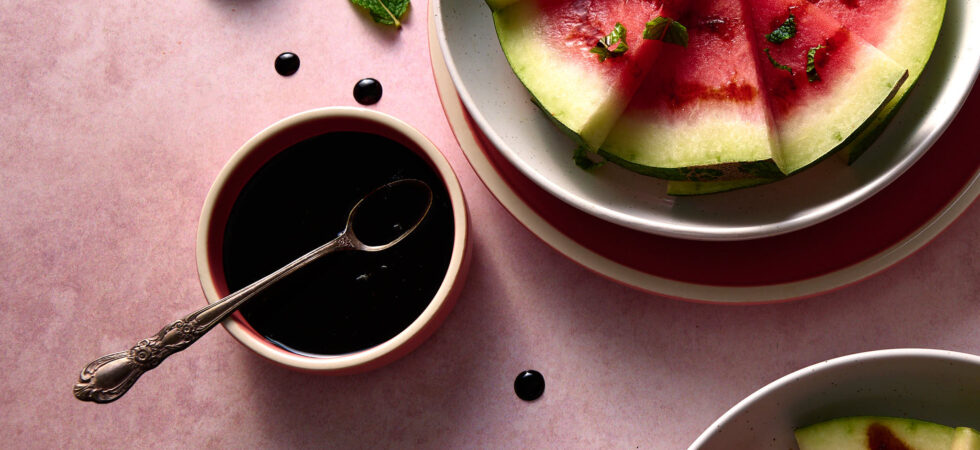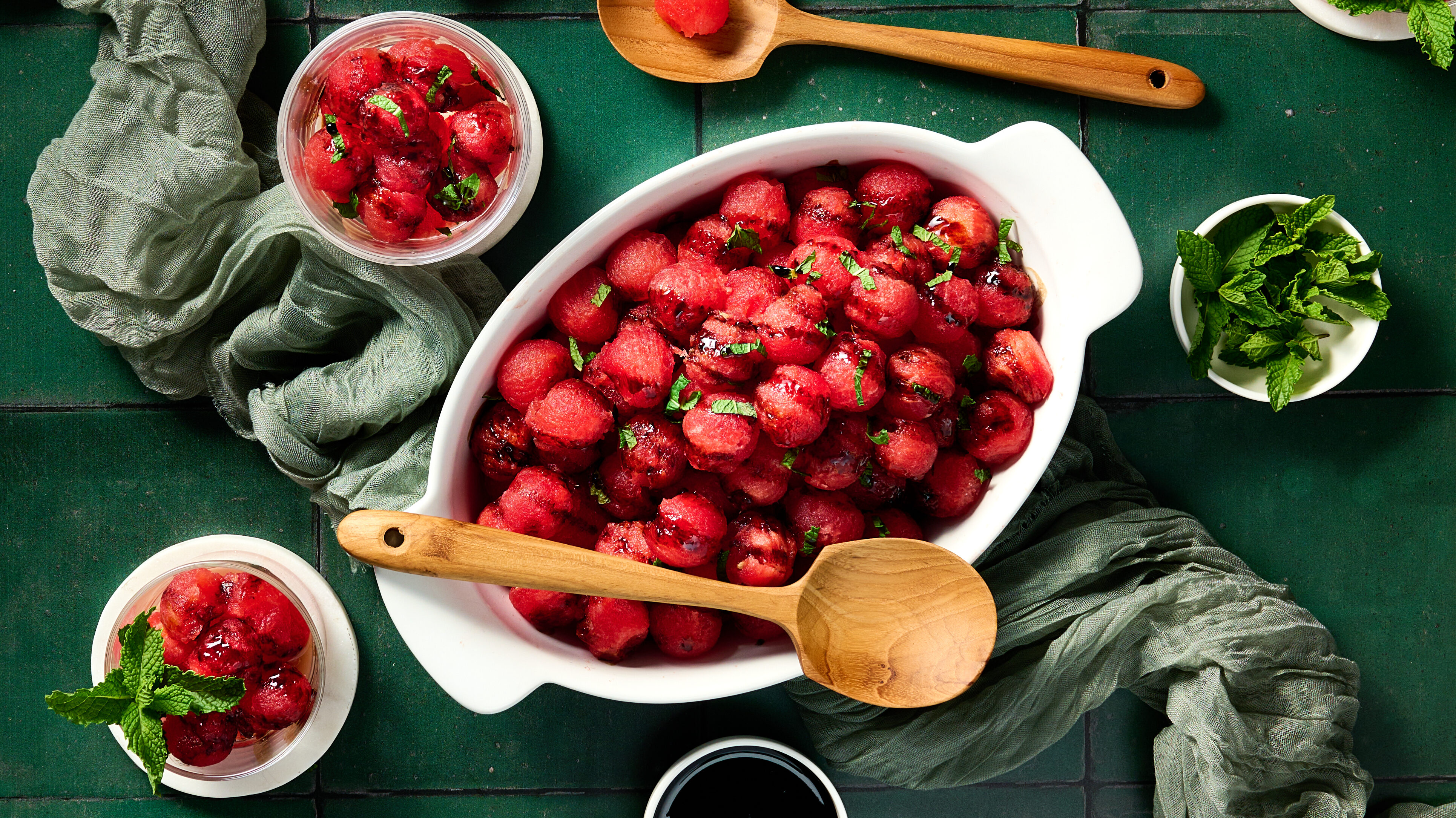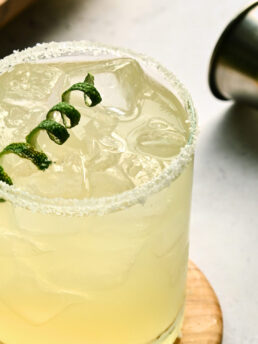Watermelon Mint Salad with Tamarind Dressing

My newest obsession is this refreshing, watermelon mint fruit salad. Not only is it ridiculously easy, the drizzle made from tamarind concentrate, honey, and lime juice sends this into the stratosphere! The sweetness in the watermelon paired with the tangy acidity of the tamarind are a perfect pairing. You won’t want to bring another basic green salad to a picnic or cookout again.
Sorry to those who love leafy green salads. I’ve had some delicious ones; don’t get me wrong. But, I will forever choose a fruit salad or warm salad over cold, green leaves.

Get the Recipe: Watermelon Mint Salad with Tamarind Dressing
Ingredients
Watermelon Mint Salad Ingredients
- ¼ watermelon
- 2 tablespoons of sliced mint, about 10 medium leaves
Tamarind Drizzle Ingredients
- 1 tablespoon tamarind concentrate
- 1 tablespoon honey, (sub. agave for Vegan option)
- 1 teaspoon fresh squeezed lime juice
Equipment
- 1 chef knife
- 1 cutting board
- Measuring spoons
Instructions
- Slice the watermelon to your preferred size chunks and add them to a large bowl.
- Next, stack the mint leaves and roll them up into a long cigar shape. Make thin slices along the roll to chiffonade the mint. Once done, use your fingers to break up the strips and sprinkle them onto the watermelon. Gently toss both ingredients together, so the mint is not just on top.
- Make the drizzle by mixing all three ingredients in a small bowl.
- Portion out the salad, top with drizzle, and enjoy!
Notes
- You can either serve the watermelon mint salad in portions and then drizzle on top of each serving or serve the watermelon with small dip bowls for dipping the watermelon pieces into it. Either way, it’s best to use the drizzle just before serving, so it won’t soak into the watermelon and lose its punch.
- Consider adding fresh nectarines, mango, or cherries to the salad. Any sweet fruit that would pair well with limes.
- If you like Tajin, this is a great opportunity to use it and add some spice.
Nutrition

Frequently Asked Questions
You can definitely substitute the honey with agave, invert sugar (Lyle’s Golden Syrup), or a rich simple syrup (2 parts sugar : 1 part water) if you have them on hand. They should all be about the same level of sweetness, so a 1:1 substitute will work well for all the suggested options. The great thing is this is a simple dressing, so you can adjust any of the ingredients according to your taste.
I’m not sure what kind of tamarind products everyone will have access to locally, so here’s the deal… I’ve linked the tamarind concentrate I use in the ingredient list, so you can purchase it through Amazon. At the very least you can see a picture of the label, so you know what to buy in an Asian, South Asian, or Indian market – depending on how your local markets categorize themselves.
While I do recommend tamarind concentrate, for ease of use and sharp flavor, you may only find tamarind paste in stores. This comes either with seeds or seedless. The paste will definitely still work for the recipe, but you will need to do a few additional steps.
Fair warning, this process can be a labor of love depending on what type of paste you find. There are two types of paste, seedless and seeded.
1. If you use seedless paste, pack the paste into about 1½ tablespoons or weight out 20g. Then, drop it into the honey-lime syrup and loosen it with whatever you have on hand, like a spoon, whisk, or small spatula. Mix until it’s as incorporated as you can get it. There will be some clumped tamarind pulp in the syrup, but because you’ve worked it into the syrup it will loosen even further. Strain from there for the drizzle. You may need some extra lime, as tamarind paste isn’t quite as tangy as the concentrate. Mix to taste.
2. If you use a paste that has seeds, you still need to do the same thing, but you need to remove the seeds from the paste before you measure/weigh. (Don’t roll your eyes! I guarantee you someone would ask this question wanting to make sure they were doing things right… Also, yes, it’s me. I am that person.)
Pick it up and give it a thump. Don’t be scared of your food. It’s really important to touch/handle your produce before buying it.
If possible, hold your watermelon (test only firm ones) with one hand underneath and knock the top with your other hand. An under-ripe watermelon will give a “plink” higher-pitched, muffled sound. A ripe watermelon will have a “plunk” lower-pitched, deep sound. Rap a few melons and choose the one with the deepest sound.
Sure are. While the thump test is the fastest way to tell if a melon is ripe, It’s best to fall back on and/or consider the following criterion:
– Shape – A symmetrical watermelon is more likely to be evenly ripe. Try to find something that isn’t oddly shaped, lumpy, or dented.
– Weight – A good watermelon is going to be heavier than it looks. Water weighs more than air (it’s science!) So, the heavier the melon. the more water content within.
– Field Spots – Watermelons that ripen on the ground will have a field spot. The more ripe the watermelon, the deeper in color the field spot will be. Creamy yellow or deep yellow spots, indicate that a watermelon is fully ripe, sweet, and ready to eat. Light green or white spots mean the fruit might not be ready. If the watermelon varietal has pronounced stripes, you also shouldn’t be able to see any of them through the field spot.
– Rind Appearance – The cuticle is a natural waxy coating covering the rind that protects the watermelon as it grows. It helps retain moisture and protect against pests. As a watermelon ripens this coating will begin to degrade, giving it a matte appearance. Less shine equates to a sweeter melon.
– Rind Firmness – The watermelon shouldn’t have any mushy or bruised spots. If you can push into the rind, it’s over-ripe or might have damaged meat inside. At the same time, if the watermelon feels like it’s made of stone, it may be under-ripe.
You got it! Let’s debunk some other tips you may have seen or heard:
– You can tell if a watermelon is male or female (female is sweeter) by it’s shape – There is no such thing as female or male watermelon. There are male and female flowers. If pollinated, the female flowers grow fruit. Easy as that.
– More webbing “Pollination Points” means sweeter watermelons – Poorly pollinated watermelons won’t thrive on the vine and either produce no fruit or misshapen and bitter fruit. The watermelons you are finding at the supermarket are not going to have any of these issues. If they make it to retail, they are good to go. Webbing is believed to be caused by the natural growth and development of the watermelon. It is not directly related to the pollination process or the fruit’s sugar content.
– Round watermelons are sweeter than oval watermelons – Shape is not an indicator of water content or sweetness. The most this will affect is where the seeds are located in the watermelon. Watermelons come in different spherical shapes and sizes depending on the varietal, where they grew, when they were harvested, etc., etc.
According to the USDA, the U.S. domestic harvest times for watermelons by hardiness zones are as follows:
1. Zones 2, 3, 4: August;
2. Zones 5, 6: July – August;
3. Zones 7, 8: June – July; and
4. Zones 9, 10: April – Jul
Countries in the northern hemisphere, with the same latitudes, can expect similar growing seasons.
Here’s a link to find your U.S. hardiness zone if you’re interested.



